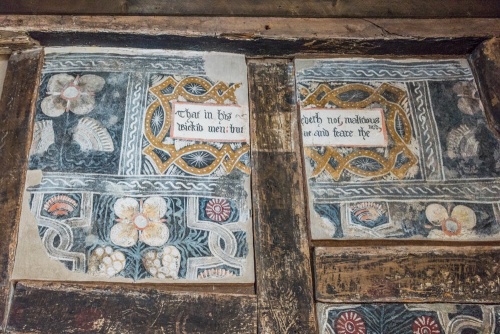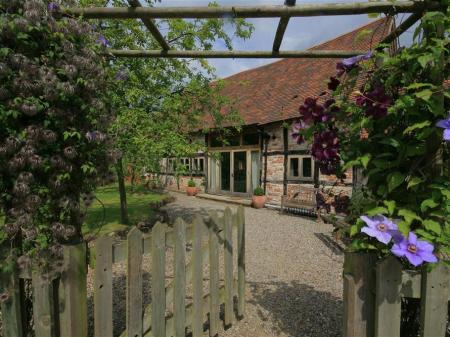
Beneath centuries-old layers of paint, plaster and wallpaper workmen discovered one of the best examples of Elizabethan wall paintings in the country, painted in the 1560s or 1570s. The wall paintings were crafted to resemble expensive tapestry or leather hangings, presumably because the actual tapestries would have been too expensive to install. They were painted directly onto the original wattle and daub infill between large timbers.
History
The Town Council Offices are located at the bottom of Church Lane in one of the oldest timber-framed buildings in Ledbury, constructed in the late 15th century. The chambers predate the wall paintings by some hundred years.

It is possible that the building was used as the Booth Hall, a place to administer the town markets and fairs, collect merchant's tolls, distribute poor law money, control vagrants and hold the Court of Piepowder.
The latter comes from the French 'Pied Poudre', or 'dusty feet', a reference to the fact that people coming to the market in Ledbury often travelled great distances and arrived covered in the dust of the road. The Booth Hall is known to have had a lock-up, and a brick-built cell was discovered in the cellar of the Town Council Offices.
Given this evidence, it seems likely that the resident of the Painted Room as the Town Constable, who in the late 16th century was Sergeant Richard Skull.

Wallpaper was unknown in the late medieval and early Tudor period. If you could afford it you hung expensive tapestries on your walls, and if not you made do with leather or cloth hangings, known as Hessian. These wall hangings served two purposes; they showed the householder's wealth and taste, and on a more practical note they helped keep out drafts.
Here in Ledbury, it is clear that the owner could not afford expensive tapestries, so he had the walls of this first-floor chamber painted to resemble expensive wall hangings. The Painted Room decorations are similar to those in a 1585 painting depicting Elizabeth I receiving a state visit from foreign dignitaries in her Privy Chamber.

The Wall Paintings
The colours used to decorate the Painted Room are natural earth pigments; raw umber, earth green, lime white, artificial copper blue, red lead, red and yellow ochre and charcoal black. The pigments were mixed with a glue base made by boiling together animal hoofs, bones and horn. The wattle and daub walls were primed with a thin coating of plaster made of lime and hair and the pigment was applied onto the damp surface.
The painted designs are abstract, and similar to Elizabethan embroidery designs. Similar designs were used for 16th-century knot gardens. The basis of the design is a repeating quatrefoil (four-leafed) representing the paths of a traditional Tudor knot garden.
Within the quatrefoil are fruit, flowers and leaves against a black background. At ceiling height is a valence with panels of Biblical text inside red and yellow strapwork patterns. The text is black with red punctuation marks.
There are three text panels. The first, near the door, is Psalm 15 from the 'Booke of Psalms collected into English Meeter' published in 1549. Over the top of the window is Proverbs 15 from the Geneva Bible of 1557. The final text box contains a fragment of Psalm 111 from the 1549 psalter printed to accompany Edward VI's First Prayer Book. The texts are incomplete and very worn in places, making interpretation difficult.
In one corner of the room, the pattern changes to resemble wooden panelling. This fake panelling probably extended around the entire room to a height of three feet.

Symbolism
The wall paintings are meant to be much more than simply a pleasing abstract design; each part of the design is symbolic. Large white flowers abound; they may be roses, symbolising beauty, love and joy (or perhaps they are strawberry flowers, symbolic of purity and innocence).
You can see bunches of what appear to be grapes, representing the Blood of Christ. Then there are carnations, symbolising poverty and maternal love, and daisies, for humility.
Many of these floral and fruit symbols are tied closely to the Virgin Mary in Biblical interpretation, and also to Elizabeth I.
The 'Virgin Queen' was born on the eve of a feast day linked to the Virgin Mary, and always felt a close link with Mary. The queen also was fond of both strawberries and roses in the design of her gowns, again emphasising the link. So here in the Painted Room, we have designs that are symbolic of religious belief but also act as a statement of patriotism to the reigning monarch.

The Painted Room is located a few steps away from the attractive 17th-century Market House on Ledbury High Street. The Painted Room staff have keys to the first-floor chamber of the Market House, which is normally kept locked. We asked nicely and our very knowledgeable guide was happy to get the keys and show us the chamber.
The Painted Room is free to visit and is well worth taking the time to explore.
 We've 'tagged' this attraction information to help you find related historic attractions and learn more about major time periods mentioned.
We've 'tagged' this attraction information to help you find related historic attractions and learn more about major time periods mentioned.




